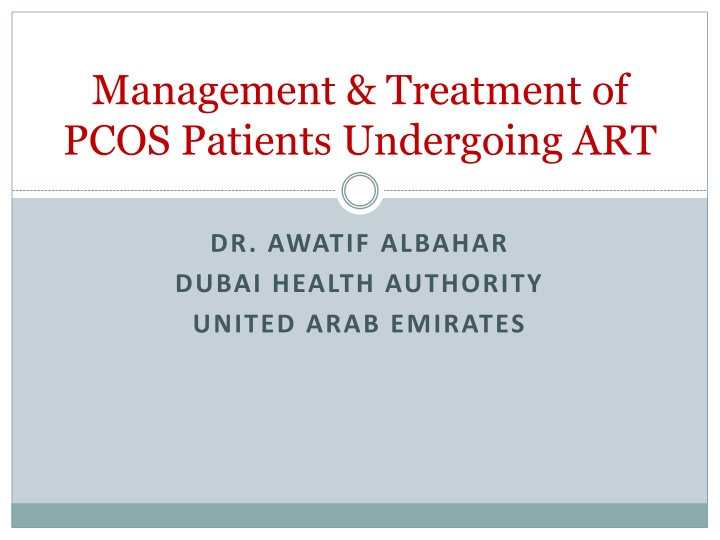
Management and Treatment of PCOS Patients Undergoing ART in Dubai Health Authority UAE
Learn about the epidemiology and economic impact of Polycystic Ovary Syndrome (PCOS) in women, along with recommended treatments including induction of ovulation and medications like Clomid. Understanding the implications of PCOS on fertility and the role of different treatments can help in managing patients, especially those undergoing ART procedures.
Download Presentation

Please find below an Image/Link to download the presentation.
The content on the website is provided AS IS for your information and personal use only. It may not be sold, licensed, or shared on other websites without obtaining consent from the author. If you encounter any issues during the download, it is possible that the publisher has removed the file from their server.
You are allowed to download the files provided on this website for personal or commercial use, subject to the condition that they are used lawfully. All files are the property of their respective owners.
The content on the website is provided AS IS for your information and personal use only. It may not be sold, licensed, or shared on other websites without obtaining consent from the author.
E N D
Presentation Transcript
Management & Treatment of PCOS Patients Undergoing ART DR. AWATIF ALBAHAR DUBAI HEALTH AUTHORITY UNITED ARAB EMIRATES
Epidemiology PCOS affects 5% to 10% of women of reproductive age - 4 million individuals. It s prevalence among infertile women is 15% to 20%. Most common endocrine disorder of women within this age group. Observed within the student health population & general medical practice, though most often when a woman presents with infertility.
Epidemiology Continued PCOS 95% of all cases of hyperandrogenism 20% of all cases of amenorrhea 75% of all cases of anovulatory infertility
Economic Cost to Health Care According to the Health Care-Related Economic Burden of the Polycystic Ovary Syndrome, they stated, We estimated the mean annual cost of the initial evaluation to be $93 million, that of hormonally treating menstrual dysfunction/abnormal uterine bleeding to be $1.35 billion, that of providing infertility care to be $533 million, that of PCOS-associated diabetes to be $1.77 billion, and that of treating hirsutism to be $622 million.
Treatment Recommended Induction of Ovulation Clomid Recombinant FSH Metformin Invitro Fertilization
Clomiphene (Simulate Ovulation) n = 5268 Ovulation 3858 (73%) Pregnancies 1909 (36%) Miscarriage 20% Multiple Pregnancy Rate 8% Homburg, Hum Reprod, 2005
Should we monitor Clomiphene cycles with ultrasound? With U/S + hCG No U/S or hCG n 105 150 Cumulative Pregnancy Rate 48% 34.7% Deliveries 35.6% 26.7% Multiple Pregnancies 0 1
Anti-Estrogen Effect on Endometrium Endometrial thinning in 15-50% Causes ER down regulation and depletion Suppresses pinopode formation Less pregnancies when endometrial thickness at midcycle < 7mm Not dose related and recurs in repeat cycles
Aromatase Inhibitors Letrozole Advantages: Do not block estrogen receptors No detrimental effect on endometrium or cervical mucus. Negative feedback mechanism not turned off less chance of multiple follicular development.
Letrozole vs. Clomiphene Legro et al, NEJM 2014 N = 750 PCOS, RCT Letrozole CC P Ovulation 61.4% 48.3% 0.001 Pregnancy Loss 31.8% 28.2% NS Twins 3.2% 7.4% NS Live Births 27.5% 19.5% 0.007
Insulin-Sensitizing Drugs for Women with PCOS, Oligo/Amenorrhea & Subfertility Tang et al. Cochrane Database, 2009 There is no evidence that metformin improves live birth rates whether it is used alone or in combination with clomiphene. Therefore, the use of metformin is improving reproductive outcomes in women with PCOS appears to be limited.
Metformin Useful but not recommended for ovulation induction. Less multiple pregnancies than CC. May be useful for CC resistance.
Metformin in IVF Short term co-treatment with metformin for PCOS in IVF/ICSI: Does not improve response to stimulation Improves pregnancy rates Reduces the risk of OHSS No difference: Total dose FSH No. of oocytes Fertilization rates
Gonadotropin Treatment: Why is PCOS Different? Greater sensitivity to gonadotropin stimulation, therefore, multiple ( explosive ) follicular development.
Incremental Dose Rise 50 IU starting dose; increments of 25 or 50 IU n=158 Start day 3 of menses 150 IU daily 100 IU daily125 IU daily 7 days 75 IU daily 7 days 7 days 50 IU daily 7 days 7 days 1 8 15 22 29 35 250 IU daily 200 IU daily 150 IU daily 7 days 100 IU daily 7 days 7 days 50 IU daily 7 days 7 days 1 8 15 22 29 36 Days of treatment Only allowed when no follicle 12 mm 1 follicle 18 mm 3 follicles 15 mm FSH increments: hCG: Cancellation: Leader et al, 2006
P=0.009 100 25 IU increments 50 IU increments 81.3 75 60.3 P=0.009 50 41.3 21.8 25 0 Ovulation rate Monofollicular cycle rate Higher cancellation rate with 50 IU increments Duration and Pregnancy rate same Leader et al, 2006
Low dose rec-FSH 100-150 IU 75-112.5 IU 50-75 IU 14 7 7 Days
Only Minimal Dose Increment Needed Incremental dose rise of 8.3 IU each week 64.6 IU 58.3 IU 50 IU 7 14 21 Days N=25, PCOS, CC failures, 69 cycles Orvieto & Homburg, 2008
Low-Dose Gonadotropins: Summary of Results Patients 1040, Cycles 2472 Pregnancies 411 (40%) Fecundity/ovarian cycle 23% Uniovulation 71% OHSS 0.14% Multiple Pregnancies 5.1% Updated from Homburg & Howles, 1999
Conventional Regimen With Gonadotropins 75 75 75 5 5 5 5 Days
Results of Conventional Therapy: 14 Series, 1966-1984, WHO I &II Conceived 46% (16-78) Multiple Pregnancies 34% (22-50) Miscarriages 23% (12-30) Severe OHSS 4.6% (1.3-9.4) Updated from Homburg & Howles, 1999
How Long Does It Take? With a starting dose of 75 IU FSH, unchanged for a minimum of 14 days 90% will get to the criteria for hCG
PCOS Why Antagonist? Shorter duration of stimulation with GnRH antagonist Gonadotropin requirements are decreased compared to GnRH agonists OHSS incidence decreased Allows the use of an agonist trigger
High Responders (AMH > 20 pmol/L) Treatment strategy: Control GnRH antagonist starting day S4 (3) Daily FSH dose = 150 IU hMG (obese = 225)
0.25mg/day antagonist FSH hCG Day 5 , 6 or 7 antagonist start 0.25mg/day antagonist FSH GnRH agonist
0.25mg/day antagonist FSH Day 5 start FIXED GnRH agonist Luteal phase support possibilities: 1. Massive doses Progesterone (i/m 50mg/day) +E2 2. 1500 IU hCG on day OPU (Humaidan 2009) 3. Freeze all embryos and transfer in natural cycle
0.25mg/day antagonist FSH Day 5 start FIXED GnRH agonist Luteal phase support: 1500 IU hCG on day OPU No significant difference in outcome compared with hCG trigger
Iliodromiti et al, Human Reproduction, 28 : 2529-36, 2013 N=275 at high risk of OHSS Agonist trigger + hCG 1500 IU on day of OPU Vaginal progesterone + E2 valerate b.d. Clinical pregnancy rate = 41.8% Severe OHSS 2 cases (0.72%)
Overcoming the Problems for PCOS in IVF Avoid OHSS! Diagnosis and mild stimulation Oral contraceptive pre-treatment Antagonist GnRH agonist to trigger ovulation Medication Metformin Freeze embryos
Best Advice If > 25 follicles > 11mm Freeze all embryos! Replace a natural cycle.
Thank You !!! - DR. AWATIF
References Azziz, R. et al., Health Care-Related Economic Burden of the Polycystic Ovary Syndrome during the Reproductive Life Span, J Clin Endocrinol Metab, August 2005, 90(8):4650 4658. Badaway, A., Elnashar, A,. Treatment options for polycystic ovary syndrome, International Journal of Women s Health 2011;3:25-35 Boomsma CM, Fauser BC, Macklon NS. Pregnancy complications in women with polycystic ovary syndrome, Semin Reprod Med 2008, 26 (1), 72 84. Eid GM, Cottam DR, Velcu et al. Effective treatment of polycystic ovarian syndrome with Roux-en-Y gastric bypass. Surg. Obes. Relat. Dis. 1(2), 77-80 (2005). Escobar-Morreale HF, Botella-Carretero JI, Alvarez-Blasco F, Sancho J, San Millan JL. The polycystic ovary syndrome association with morbid obesity may resolve after weight loss induced by bariatric surgery. J. Clin. Endocrinol. Metab. 90, 6364-6369 (2005). Goldenberg N, Glueck C. Medical therapy in women with polycystic ovarian syndrome before and during pregnancy and lactation, Minerva Ginecol 2008, 60 (1), 63 75.
References continued Norman RJ, Noakes M, Wu R, Davies MJ, Moran L, Wang XJ. Improving reproductive performance in overweight/obese women with effective weight management. Hum. Reprod. Update 10, 267-280 (2004). Pasquali, R., Gambineri, A., Insulin-sensitizing agents in polycystic ovary syndrome, European Journal of Endocrinology June 1, 2006; 154:763-775. Sjostrom L, Narbro K, Sjostrom CD et al. Effects of bariatric surgery on mortality in Swedish obese subjects. N. Engl. J. Med. 357, 741-52 (2007). Teede, Helena j. et al., Assessment and management of polycystic ovary syndrome: summary of an evidence-based guideline, Med J Aust 2011; 195 (6): S65-S112. Trolle B, Flyvbjerg A, Kesmodel U, Lauszus FF. Efficacy of metformin in obese and non- obese women with polycystic ovary syndrome: a randomized, double-blinded, placebo- controlled, cross-over trial. Hum. Reprod. 22(11), 2967-2973 (2007). Vigil P, Contreras P, Alvarado JL, Godoy A, Salgado A, Cortes ME. Evidence of subpopulations with different levels of insulin resistance in women with polycystic ovary syndrome. Hum. Reprod. 22(11), 2974-2980 (2007). Vryonidou A, Papatheodorou A, Tauridou A et al. Association of hyperandrogenism and metabolic phenotype with carotid intima-media thickness in young women with polycystic ovary syndrome. J. Clin. Endocrinol. Metab. 90, 2740-2746 (2005).
Books on the PCOS Androgen Excess Disorders in Women:PCOS and Other Disorders, by Azziz,Nestler, Dewailly, Humana Press, 2006 PCOS, by Balen,Conway,Homburg,Lego, Taylor & Francis Publishers, 2005 PCOS, by Chang,Heindel, Dunaif, Marcel Dekker, Inc. 2002 PCOS, by Roy Homburg, Martin Dunitz, 2001 PCOS, by Gabor T.Kovac, Cambridge University Press, 2000 PCOS the Hidden Epidemic,by S. Thatcher, Perspectives Press, 2000
Patient Support Groups PCOSA-Polycystic Ovarian Syndrome Association, Inc.(Patient Support Group) Telephone: 877-775-PCOS Mail: P.O.Box 7007, Rosemont, Il 60018 Email:info@pcosupport.org Internet:www.pcosupport.org






















